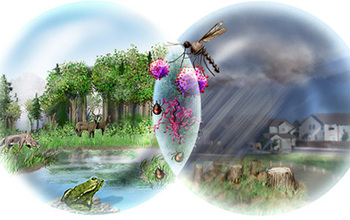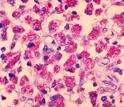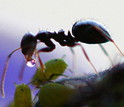NSF, NIH, partners support studies of how diseases spread among humans, other animals and the environment
 Credit and Larger Version |
Ebola, MERS (Middle East Respiratory Syndrome), malaria, antibiotic-resistant infections: Is our interaction with the environment somehow responsible for their increased incidence?
The joint National Science Foundation (NSF), National Institutes of Health (NIH) and U.S. Department of Agriculture (USDA) Ecology and Evolution of Infectious Diseases (EEID) program is providing answers.
The EEID program supports efforts to understand the ecological and biological mechanisms behind human-induced environmental changes and the emergence and transmission of infectious diseases.
Now NSF, NIH and USDA--in collaboration with the U.K.'s Biotechnology and Biological Sciences Research Council (BBSRC)--have awarded more than $12 million in new EEID grants.
"Recent outbreaks such as the Ebola and MERS viruses, as well as growing threats such as Lyme disease, demonstrate the need for fundamental understanding of pathogen movement and evolution," says Sam Scheiner, NSF program director for EEID.
"This year's EEID awards will contribute to the broader understanding of these threats the program has provided. Because of this increasing body of knowledge, we're able to respond to these new threats more efficiently and effectively."
Now in its 14th year as an interagency partnership, the program has supported 124 research projects.
Projects funded through the EEID program allow scientists to study how large-scale environmental events--such as habitat destruction, invasions of non-native species and pollution--alter the risks of emergence of viral, parasitic and bacterial diseases in humans and other animals.
"The EEID program allows us to access predictive power to more effectively respond to infectious disease," says Daniel Janes, an EEID program director at NIH. "EEID's lines of research seek to identify common dynamics of pathogens that can lead to better prevention of future threats to human health."
Researchers supported by the EEID program are advancing basic theory related to infectious diseases and improving understanding of how pathogens spread through populations.
The benefits of research on the ecology and evolution of infectious diseases include development of theories about how diseases are transmitted, improved understanding of unintended health effects of building projects, increased capacity to forecast disease outbreaks, and knowledge of how infectious diseases emerge and re-emerge.
"Agriculture is inextricably linked to the health of the people of the United States and the world--a fact that is made clear as we fight animal and plant diseases," says Sonny Ramaswamy, USDA National Institute of Food and Agriculture director.
"Research on the evolution and spread of infectious diseases will have a profound effect on our understanding of how to develop solutions that ensure safe and secure food and health for the American people."
This year's EEID awardees will conduct research on such topics as: the effects of landscape structure on disease dynamics; the risk of animal and plant infectious diseases through trade; ants as a model system to study processes influencing the transmission of infectious diseases; mycobacterial transmission in agricultural systems; and the effect of host vaccinations and genetic disease resistance on pathogen transmission, ecology and epidemiology.
"In addition to human health, the health of our livestock and crops is dependent on fundamental research on infectious diseases," says Jackie Hunter, BBSRC chief executive.
"As new threats emerge, this knowledge will enable us to respond more rapidly and effectively to safeguard health and food security."
EEID 2014 Grants:
David Hughes, Pennsylvania State University-University Park:
Charles Perrings, Arizona State University:
Sue VandeWoude, Colorado State University
Impacts of Landscape Structure, Host Demography, and Management Interventions on Disease Dynamics
Yrjo Grohn, Cornell University:
Andrew Wargo, College of William & Mary:
-NSF-
Media Contacts Cheryl Dybas, NSF, (703) 292-7734, cdybas@nsf.gov
Related WebsitesNSF Special Report: The Ecology and Evolution of Infectious Diseases: http://www.nsf.gov/news/special_reports/ecoinf/index.jsp
NSF EEID Discovery Article Series: Ten Things to Know about Lyme Disease, and other EEID articles:
http://www.nsf.gov/discoveries/disc_summ.jsp?cntn_id=131439
EEID Awards 2013: Ecology and Evolution of Infectious Disease grants support research on disease transmission:
http://www.nsf.gov/news/news_summ.jsp?cntn_id=129280
EEID Awards 2012: Controlling the Spread of Diseases Among Humans, Other Animals and the Environment:
http://www.nsf.gov/news/news_summ.jsp?cntn_id=125496
EEID Awards 2011: Investigating the Spread of Infectious Diseases With NSF, NIH, U.K. Funding: http://www.nsf.gov/news/news_summ.jsp?cntn_id=121607
NSF News: Infectious diseases and climate change intersect with no simple answers: http://www.nsf.gov/news/news_summ.jsp?cntn_id=128617
NSF News: Social Bats Pay a Price: Fungal Disease, White-Nose Syndrome ... Extinction?: http://www.nsf.gov/news/news_summ.jsp?cntn_id=124679
NSF News: History is Key Factor in Plant Disease Virulence: http://www.nsf.gov/news/news_summ.jsp?cntn_id=123869
NSF News: Precautions for Tick-Borne Disease Extend "Beyond Lyme": http://www.nsf.gov/news/news_summ.jsp?cntn_id=124286
NSF News: Biodiversity Loss: Detrimental to Your Health: http://www.nsf.gov/news/news_summ.jsp?cntn_id=118114
The National Science Foundation (NSF) is an independent federal agency that supports fundamental research and education across all fields of science and engineering. In fiscal year (FY) 2014, its budget is $7.2 billion. NSF funds reach all 50 states through grants to nearly 2,000 colleges, universities and other institutions. Each year, NSF receives about 50,000 competitive requests for funding, and makes about 11,500 new funding awards. NSF also awards about $593 million in professional and service contracts yearly.
Useful NSF Web Sites:
NSF Home Page:
http://www.nsf.gov
NSF News:
http://www.nsf.gov/news/
For the News Media:
http://www.nsf.gov/news/newsroom.jsp
Science and Engineering Statistics:
http://www.nsf.gov/statistics/
Awards Searches:
http://www.nsf.gov/awardsearch/
EEID awardees will study landscape structure and diseases in species like Florida panthers.
Credit and Larger Version

The transmission of mycobacteria in agricultural systems is the focus of an EEID grant.
Credit and Larger Version

The risk of animal and plant infectious diseases spreading through trade is growing.
Credit and Larger Version

EEID scientists will conduct research on disease resistance in fish such as trout and salmon.
Credit and Larger Version

Ants are a model system for studying processes that influence transmission of infectious diseases.
Credit and Larger Version
The National Science Foundation (NSF)
Guillermo Gonzalo Sánchez Achutegui
ayabaca@gmail.com
ayabaca@hotmail.com
ayabaca@yahoo.com
Inscríbete en el Foro del blog y participa : A Vuelo De Un Quinde - El Foro!

No hay comentarios:
Publicar un comentario